MGMT20140 - Design Thinking: Approaches, Benefits for Organizations
VerifiedAdded on 2024/06/28
|6
|829
|487
Report
AI Summary
This report provides a concise overview of design thinking, emphasizing its human-centered approach and potential benefits for organizations. It defines design thinking as a mindset that encourages different ways of asking questions and solving problems. The report outlines key approaches to design thinking, including visualizing, prototyping, brainstorming, and testing, highlighting the importance of each step in fostering creative problem-solving. It further discusses essential aspects of design thinking such as empathy, ideation, and experimentation. Finally, the report details the benefits of design thinking for organizations, including risk reduction, faster learning, and the development of an innovative culture.
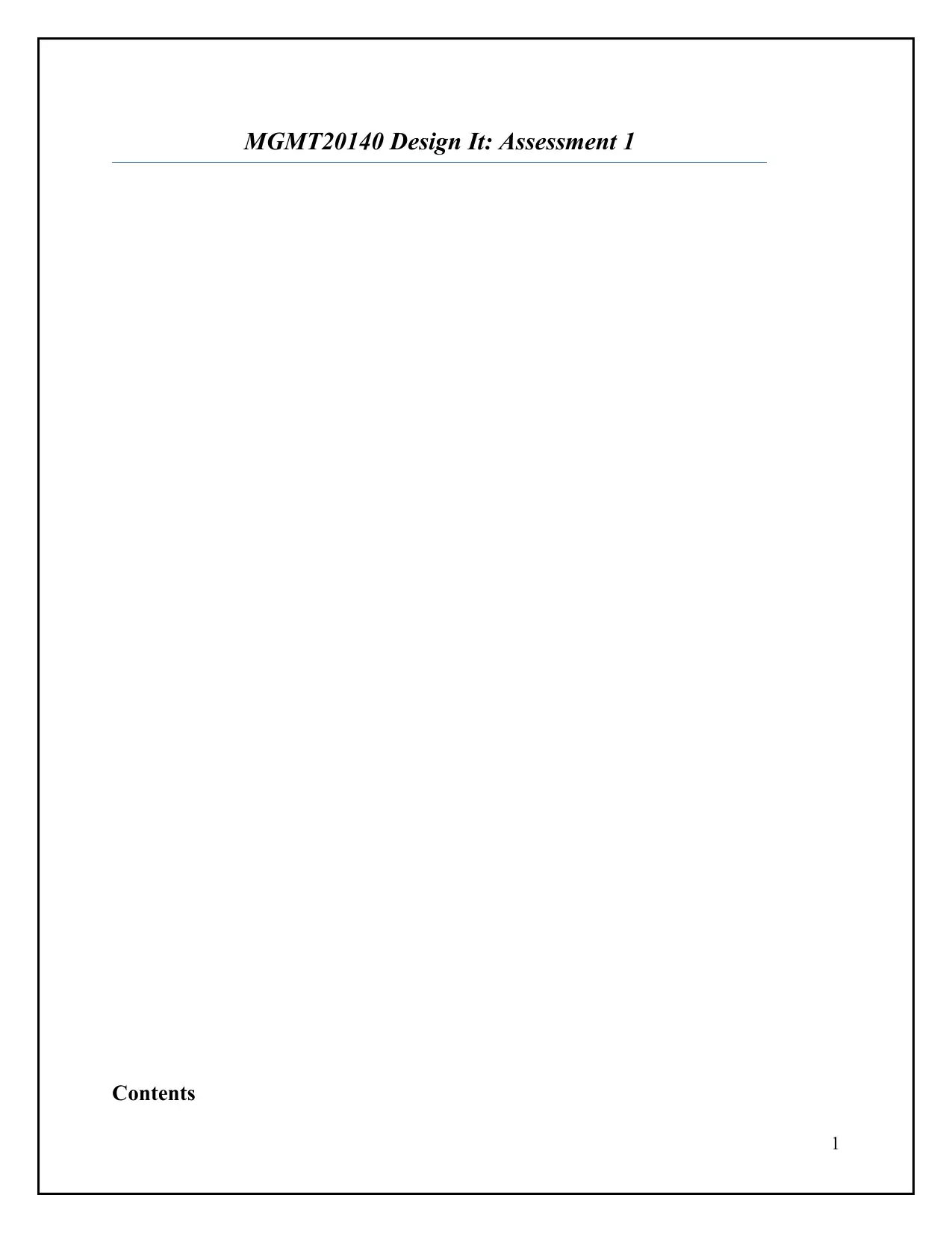
MGMT20140 Design It: Assessment 1
Contents
1
Contents
1
Paraphrase This Document
Need a fresh take? Get an instant paraphrase of this document with our AI Paraphraser

Poster............................................................................................................................................... 3
Summary..........................................................................................................................................3
References........................................................................................................................................6
2
Summary..........................................................................................................................................3
References........................................................................................................................................6
2
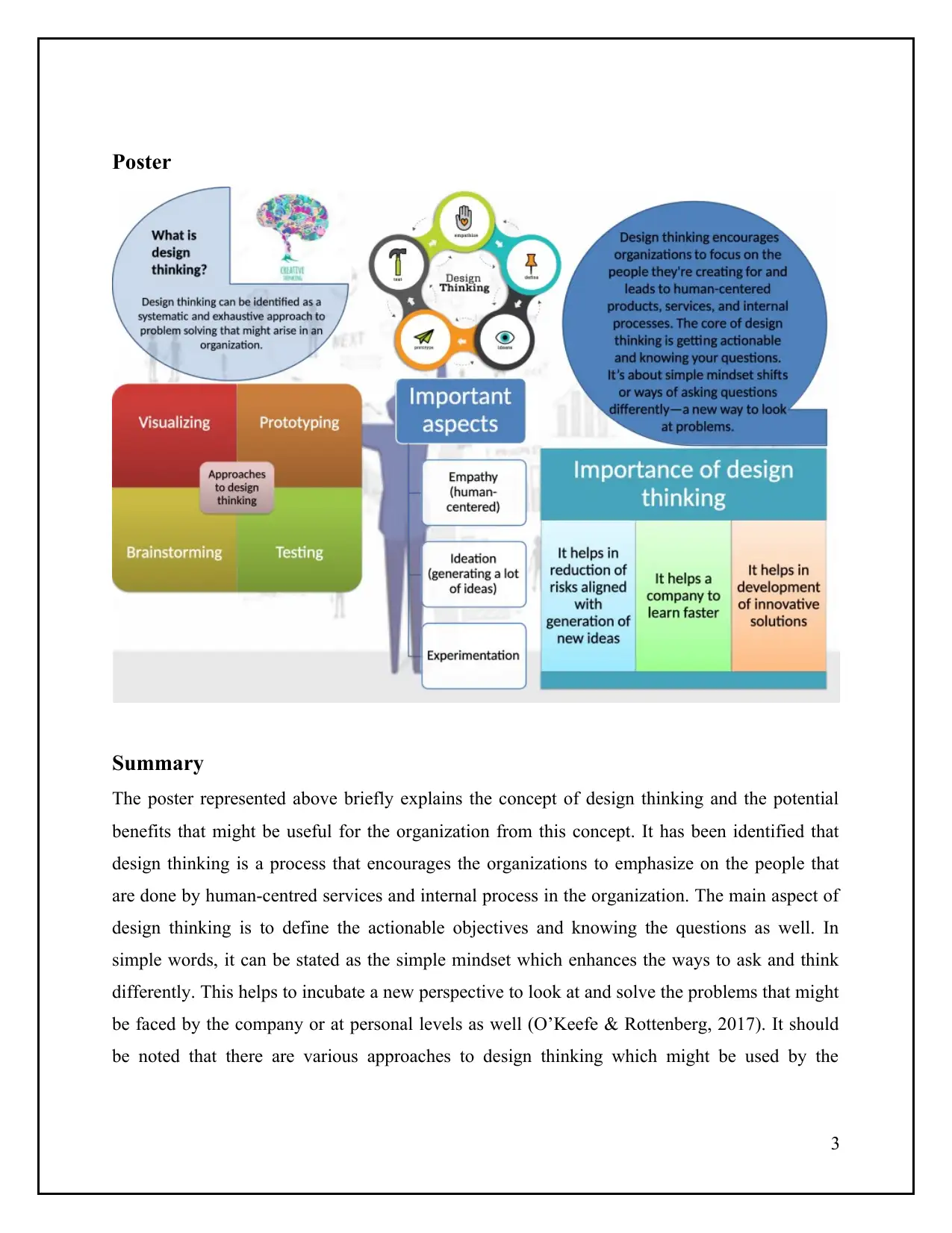
Poster
Summary
The poster represented above briefly explains the concept of design thinking and the potential
benefits that might be useful for the organization from this concept. It has been identified that
design thinking is a process that encourages the organizations to emphasize on the people that
are done by human-centred services and internal process in the organization. The main aspect of
design thinking is to define the actionable objectives and knowing the questions as well. In
simple words, it can be stated as the simple mindset which enhances the ways to ask and think
differently. This helps to incubate a new perspective to look at and solve the problems that might
be faced by the company or at personal levels as well (O’Keefe & Rottenberg, 2017). It should
be noted that there are various approaches to design thinking which might be used by the
3
Summary
The poster represented above briefly explains the concept of design thinking and the potential
benefits that might be useful for the organization from this concept. It has been identified that
design thinking is a process that encourages the organizations to emphasize on the people that
are done by human-centred services and internal process in the organization. The main aspect of
design thinking is to define the actionable objectives and knowing the questions as well. In
simple words, it can be stated as the simple mindset which enhances the ways to ask and think
differently. This helps to incubate a new perspective to look at and solve the problems that might
be faced by the company or at personal levels as well (O’Keefe & Rottenberg, 2017). It should
be noted that there are various approaches to design thinking which might be used by the
3
⊘ This is a preview!⊘
Do you want full access?
Subscribe today to unlock all pages.

Trusted by 1+ million students worldwide
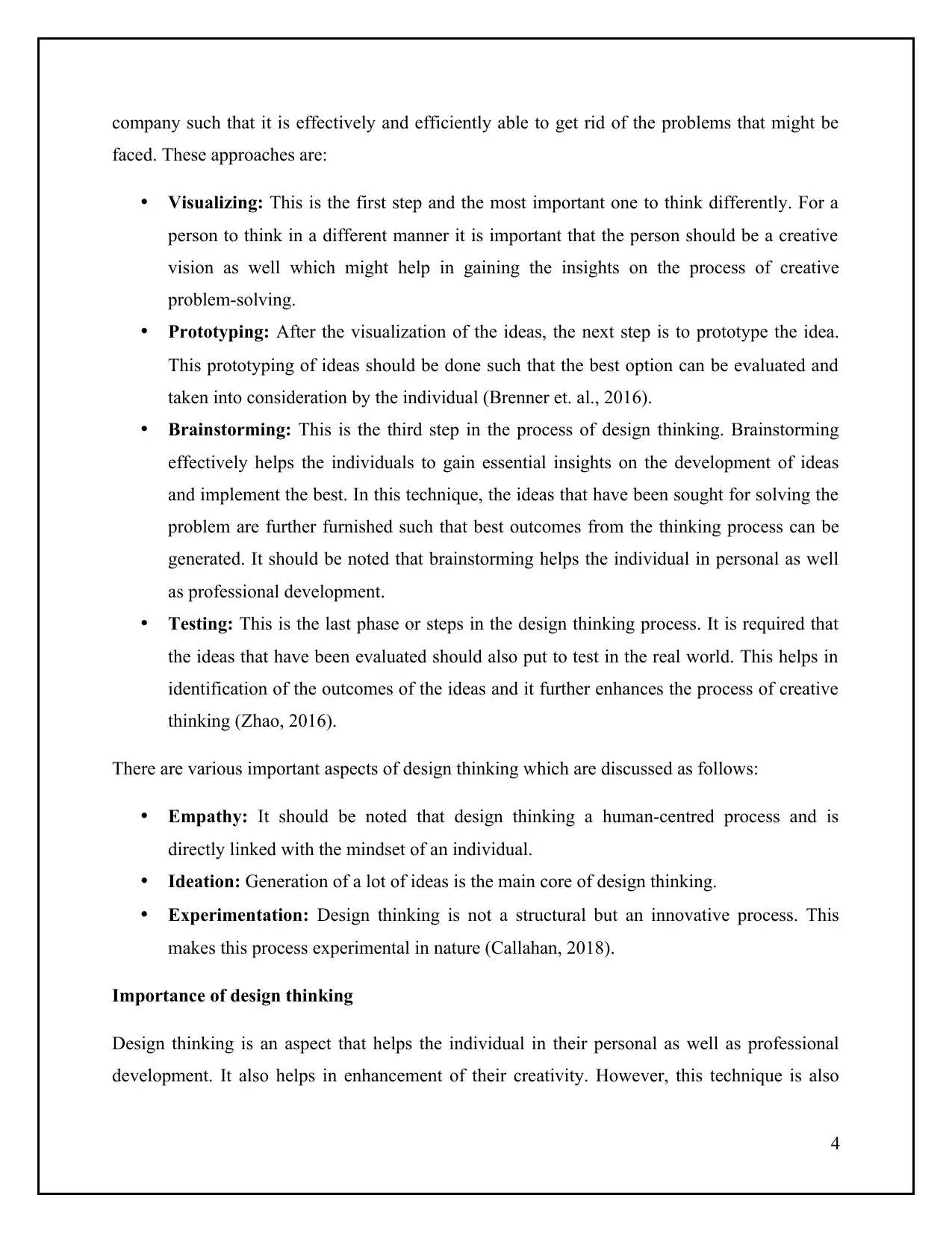
company such that it is effectively and efficiently able to get rid of the problems that might be
faced. These approaches are:
Visualizing: This is the first step and the most important one to think differently. For a
person to think in a different manner it is important that the person should be a creative
vision as well which might help in gaining the insights on the process of creative
problem-solving.
Prototyping: After the visualization of the ideas, the next step is to prototype the idea.
This prototyping of ideas should be done such that the best option can be evaluated and
taken into consideration by the individual (Brenner et. al., 2016).
Brainstorming: This is the third step in the process of design thinking. Brainstorming
effectively helps the individuals to gain essential insights on the development of ideas
and implement the best. In this technique, the ideas that have been sought for solving the
problem are further furnished such that best outcomes from the thinking process can be
generated. It should be noted that brainstorming helps the individual in personal as well
as professional development.
Testing: This is the last phase or steps in the design thinking process. It is required that
the ideas that have been evaluated should also put to test in the real world. This helps in
identification of the outcomes of the ideas and it further enhances the process of creative
thinking (Zhao, 2016).
There are various important aspects of design thinking which are discussed as follows:
Empathy: It should be noted that design thinking a human-centred process and is
directly linked with the mindset of an individual.
Ideation: Generation of a lot of ideas is the main core of design thinking.
Experimentation: Design thinking is not a structural but an innovative process. This
makes this process experimental in nature (Callahan, 2018).
Importance of design thinking
Design thinking is an aspect that helps the individual in their personal as well as professional
development. It also helps in enhancement of their creativity. However, this technique is also
4
faced. These approaches are:
Visualizing: This is the first step and the most important one to think differently. For a
person to think in a different manner it is important that the person should be a creative
vision as well which might help in gaining the insights on the process of creative
problem-solving.
Prototyping: After the visualization of the ideas, the next step is to prototype the idea.
This prototyping of ideas should be done such that the best option can be evaluated and
taken into consideration by the individual (Brenner et. al., 2016).
Brainstorming: This is the third step in the process of design thinking. Brainstorming
effectively helps the individuals to gain essential insights on the development of ideas
and implement the best. In this technique, the ideas that have been sought for solving the
problem are further furnished such that best outcomes from the thinking process can be
generated. It should be noted that brainstorming helps the individual in personal as well
as professional development.
Testing: This is the last phase or steps in the design thinking process. It is required that
the ideas that have been evaluated should also put to test in the real world. This helps in
identification of the outcomes of the ideas and it further enhances the process of creative
thinking (Zhao, 2016).
There are various important aspects of design thinking which are discussed as follows:
Empathy: It should be noted that design thinking a human-centred process and is
directly linked with the mindset of an individual.
Ideation: Generation of a lot of ideas is the main core of design thinking.
Experimentation: Design thinking is not a structural but an innovative process. This
makes this process experimental in nature (Callahan, 2018).
Importance of design thinking
Design thinking is an aspect that helps the individual in their personal as well as professional
development. It also helps in enhancement of their creativity. However, this technique is also
4
Paraphrase This Document
Need a fresh take? Get an instant paraphrase of this document with our AI Paraphraser
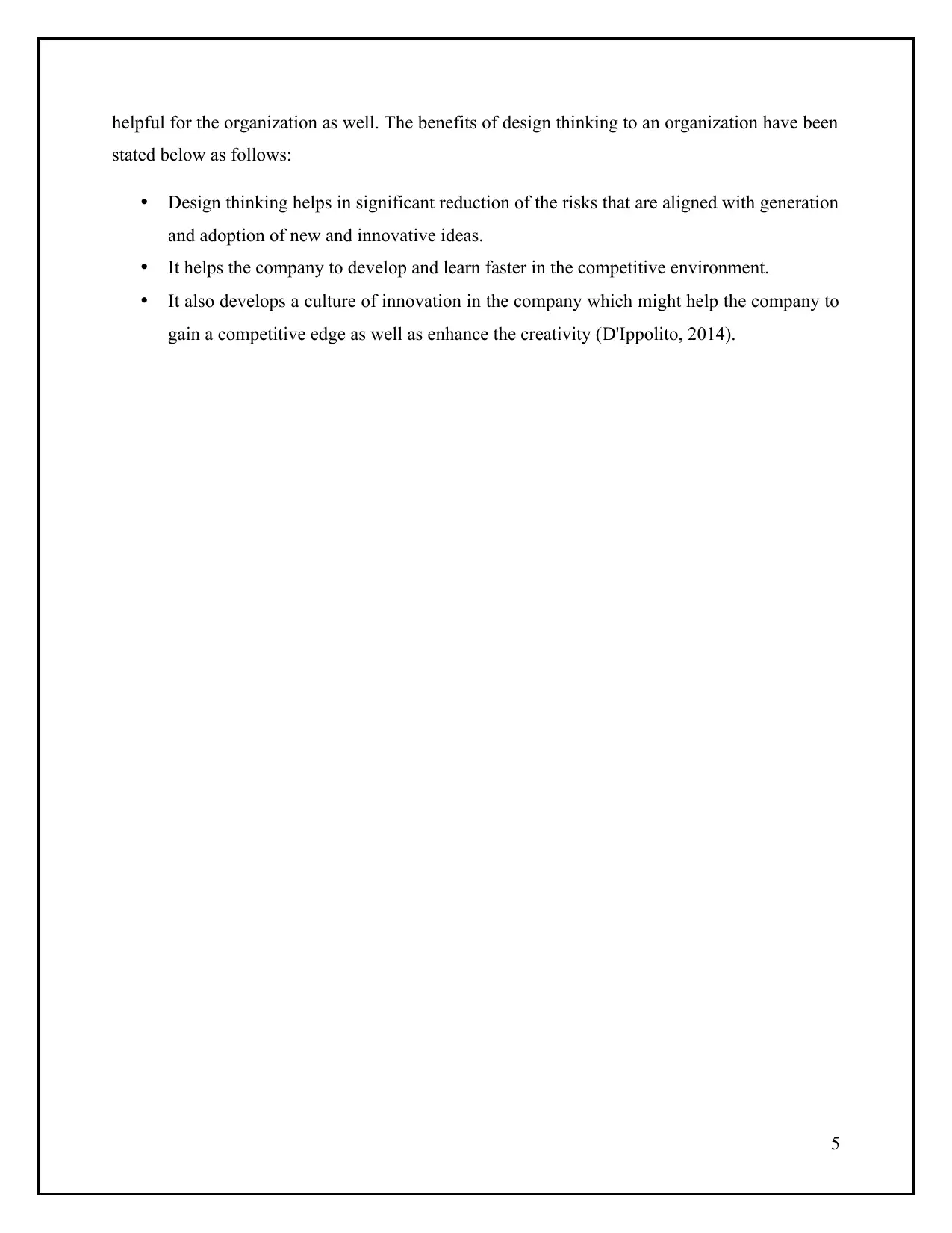
helpful for the organization as well. The benefits of design thinking to an organization have been
stated below as follows:
Design thinking helps in significant reduction of the risks that are aligned with generation
and adoption of new and innovative ideas.
It helps the company to develop and learn faster in the competitive environment.
It also develops a culture of innovation in the company which might help the company to
gain a competitive edge as well as enhance the creativity (D'Ippolito, 2014).
5
stated below as follows:
Design thinking helps in significant reduction of the risks that are aligned with generation
and adoption of new and innovative ideas.
It helps the company to develop and learn faster in the competitive environment.
It also develops a culture of innovation in the company which might help the company to
gain a competitive edge as well as enhance the creativity (D'Ippolito, 2014).
5
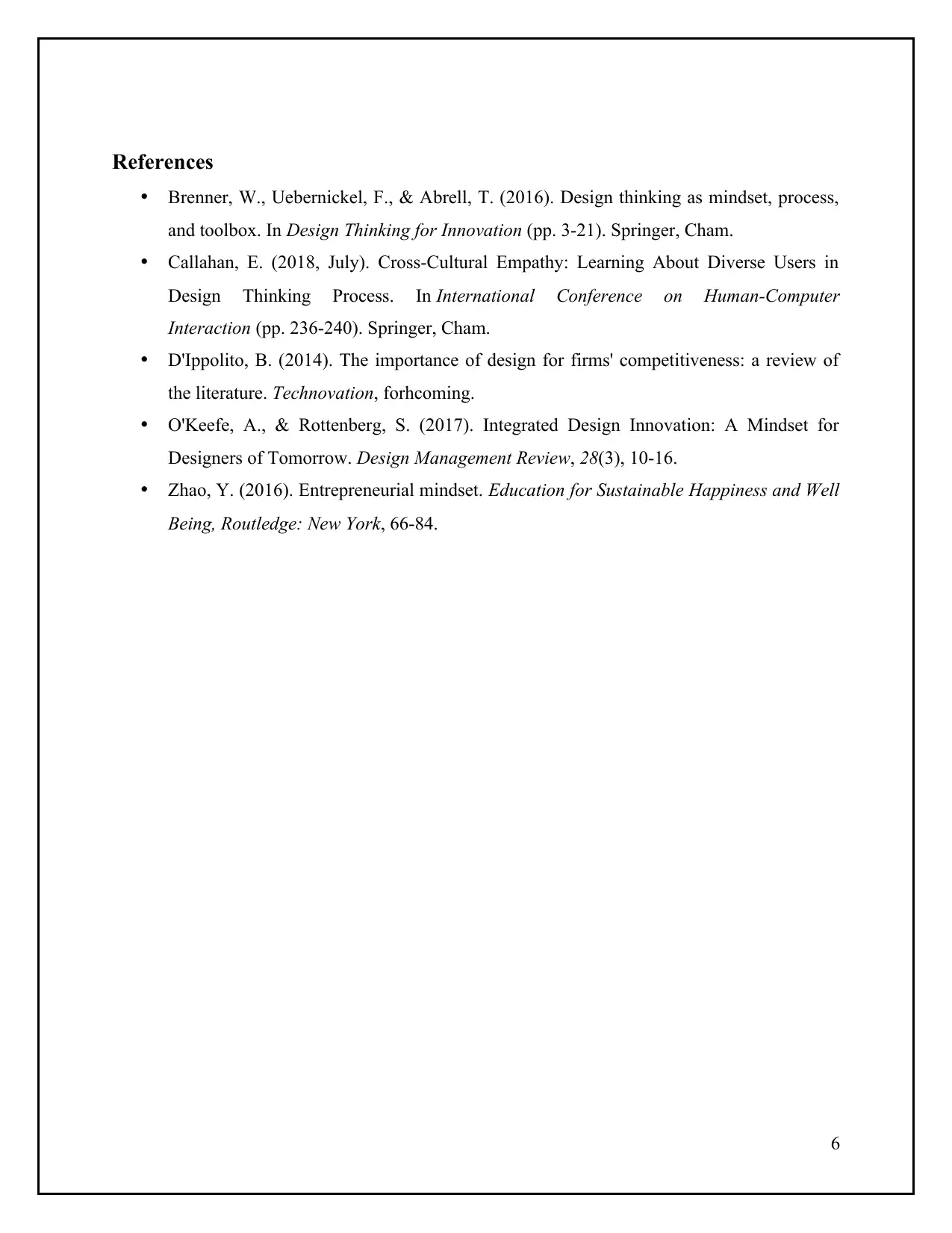
References
Brenner, W., Uebernickel, F., & Abrell, T. (2016). Design thinking as mindset, process,
and toolbox. In Design Thinking for Innovation (pp. 3-21). Springer, Cham.
Callahan, E. (2018, July). Cross-Cultural Empathy: Learning About Diverse Users in
Design Thinking Process. In International Conference on Human-Computer
Interaction (pp. 236-240). Springer, Cham.
D'Ippolito, B. (2014). The importance of design for firms' competitiveness: a review of
the literature. Technovation, forhcoming.
O'Keefe, A., & Rottenberg, S. (2017). Integrated Design Innovation: A Mindset for
Designers of Tomorrow. Design Management Review, 28(3), 10-16.
Zhao, Y. (2016). Entrepreneurial mindset. Education for Sustainable Happiness and Well
Being, Routledge: New York, 66-84.
6
Brenner, W., Uebernickel, F., & Abrell, T. (2016). Design thinking as mindset, process,
and toolbox. In Design Thinking for Innovation (pp. 3-21). Springer, Cham.
Callahan, E. (2018, July). Cross-Cultural Empathy: Learning About Diverse Users in
Design Thinking Process. In International Conference on Human-Computer
Interaction (pp. 236-240). Springer, Cham.
D'Ippolito, B. (2014). The importance of design for firms' competitiveness: a review of
the literature. Technovation, forhcoming.
O'Keefe, A., & Rottenberg, S. (2017). Integrated Design Innovation: A Mindset for
Designers of Tomorrow. Design Management Review, 28(3), 10-16.
Zhao, Y. (2016). Entrepreneurial mindset. Education for Sustainable Happiness and Well
Being, Routledge: New York, 66-84.
6
⊘ This is a preview!⊘
Do you want full access?
Subscribe today to unlock all pages.

Trusted by 1+ million students worldwide
1 out of 6
Related Documents
Your All-in-One AI-Powered Toolkit for Academic Success.
+13062052269
info@desklib.com
Available 24*7 on WhatsApp / Email
![[object Object]](/_next/static/media/star-bottom.7253800d.svg)
Unlock your academic potential
Copyright © 2020–2025 A2Z Services. All Rights Reserved. Developed and managed by ZUCOL.




